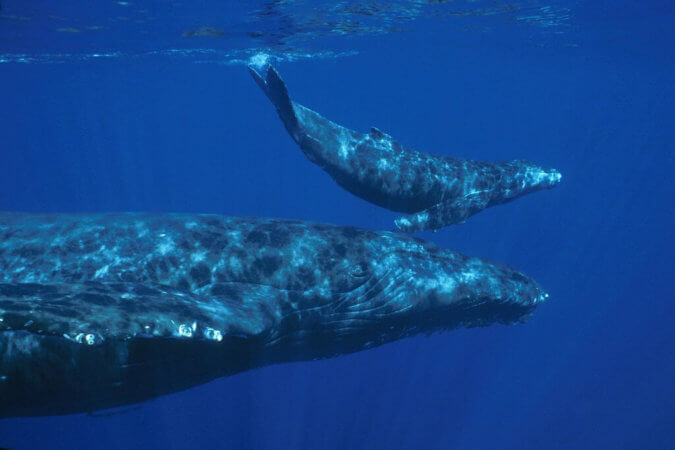Within the animal kingdom, most species adjust their periods of sleep and activity according to a repeated 24-hour cycle called the circadian cycle. Some species are mainly active at night (nocturnal) – bats, owls and hedgehogs come to mind – while others are more active during the day (diurnal), including notably most primates.
“What about whales?” often ask observers and photographers, who strive to maximize their chances of seeing these animals in action. Well, it’s not that simple. Given their unique living environment, marine mammals show us that the notion of sleep and the circadian cycle is quite relative.
Variable behaviours
To find out whether whales are more diurnal or nocturnal, researchers study their behaviour during the day and at night. Unfortunately, quite often, the difference in activity is not that obvious! In Cape Cod Bay (Massachusetts, US), North Atlantic right whales have been observed – thanks to thermal imaging – surface feeding at night. A behaviour they also exhibit during the day.
And when there is a difference in activities between day and night, the results vary not only from one species to another, but also according to the geographical region and the time of year!
“In the wild in some locations bottlenose dolphins were found to be most active (displaying acoustic activity, feeding, socializing, or travel) in the early morning and late afternoon and less active at night,” explains Oleg Lyamin, behavioural ecology researcher at the University of California, in a scientific journal published in 2008. “In other places dolphins are active at night as well as during the day or even more active (mostly feeding and social behaviour, but not travelling) during nocturnal periods.”
“Another example…” adds the researcher. Sperm whales in one location off Japan dived deeper and swam faster during the day than at night (were diurnal) while in the other location, whales showed no diel rhythm in diving depths or swimming speed [according to the time of day].”
And in the Saguenay-St. Lawrence Marine Park?
Between 1994 and 1996, a study carried out by the Group for Research and Education on Marine Mammals (GREMM) used a sensor to monitor the activity of several fin whales frequenting the St. Lawrence. The results show a noticeable difference between activity that takes place during the day and that which is carried out at night. By day, fin whales seem to take longer and deeper dives (between 80 and 120 m), while their night-time activity tends to be concentrated near the surface. At night, their dives are shorter in duration and rarely more than 10 m deep.
In 2001, a new study, this time conducted on blue whales by Fisheries and Oceans Canada and GREMM, produced fairly similar results. At night, blue whale dives are shorter and not as deep as those made during the day.
A schedule dictated by their environment
In fact, this behaviour is likely linked to that of their prey. It is believed that krill, followed by the small fish that the St.Lawrence whales are fond of, perform a vertical migration at the approach of dusk, meaning they lie closer to the surface at night. The sperm whales mentioned above probably also adapt their schedules to the daily migrations of their meals in Japanese waters.
“A number of studies reported that the diel activity pattern of baleen whales depends on the availability and movement of the prey (krill) and it is coherent with the daily migration of the prey. However, this was not always the case. So, the 24-h activity pattern also depends on the time of year (breeding, calving, migration, summer feeding season), location, temperature, weather conditions, etc.,” points out Oleg Lyamin.
Thus, in cetaceans, it is observed that newborns rarely rest during their first weeks of life. During this period, in order to maintain contact, limit predation and maintain a high body temperature, the mother-calf pair swims in a slow but constant manner, independent of a circadian cycle or prey availability.
It can also be noted that captive cetaceans, which by nature are generally quite “busy” during the day, generally adopt a marked diurnal rhythm, with multiple periods of rest at night.
Never tired!
This adaptability might be facilitated by an amazing biological adaptation: the absence of the pineal gland. In most mammals, this is the gland that, depending notably on brightness levels, produces melatonin, the hormone that makes us sleepy and warns us that it is time to go to bed. However, the pineal gland is believed to be absent or non-functional in several species of whales and certain genes associated with the production or action of melatonin are inactive.
But when do they sleep?
In whales, the notion of sleep is quite relative! Since whales breathe on the surface in a conscious manner, they have developed specific solutions for resting. In this context, cetaceans are believed to have several phases of sleep per 24-hour cycle during which they rest half of their brain at a time. They take advantage of periods of calm to rest while floating on the surface, whether it’s daytime… or night-time.









